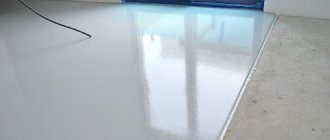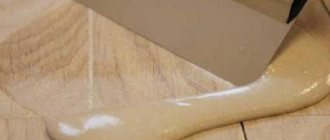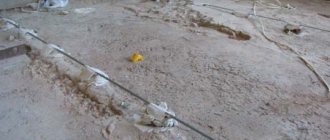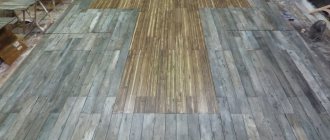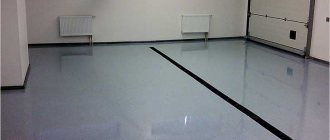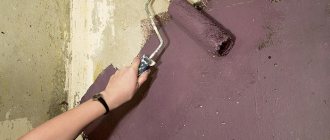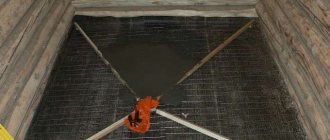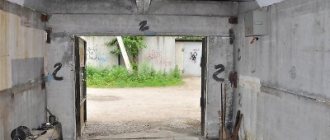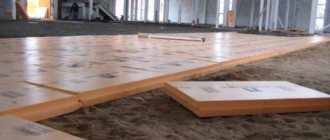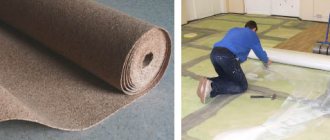Garage floors are often made of concrete, as such coatings can withstand significant loads. But after several years of operation, the garage floor, even if it remains undamaged, becomes very dirty - concrete is a porous material.
But the used coating can be painted, restoring its appearance. You can do the same with your new concrete garage floor, adding extra protection.
Coating for concrete floor in garage
Every building and structure has flooring, and a car garage is no exception. Therefore, garages for vehicles should have high-quality floors with a good coating, which will provide the car home with comfort, cleanliness and protect car parts from corrosion. There are many types of coatings, it can be regular painting, laying ceramic tiles, and many other types that can decorate and protect the concrete surface. Concrete floors, although they have high strength characteristics, but, like any building material, lose their strength properties during operation. Therefore, in order to extend the life of the floors, it is worth deciding how to cover the concrete floor in the garage?
PVC tiles
This type of flooring has appeared recently; it is made from polyvinyl chloride (PVC) with various additives. There are both options for home (PVC laminate) and for technical and industrial premises. If we talk about properties, the floor covering in a garage made of PVC tiles absorbs sounds, makes the floor warmer, is not afraid of the effects of gasoline, solvents, acids, fats, alkalis, is completely waterproof, and durable. The price is comparable to the cost of commercial linoleum.
According to the installation method, there are two types of PVC tiles - a modular covering, which is simply connected with locks and is not attached to the base, and a covering, which is glued with polymer glue. Laying requires a flat base with differences of no more than 5 mm/m2. This is perhaps the only drawback of this material: such a flat floor in a garage is the exception rather than the rule.
PVC tiles are used in commercial garages and service stations, where the load is much higher
Requirements for flooring
The concrete surface in the garage is constantly threatened by various destructive influences. The floor is affected by the weight of the vehicle, dirt from the car's wheels, and moisture that the car carries on its wheels when driving into the garage. Thus, the concrete floor covering must meet such requirements to ensure safe stay in the room, and the service life of the base is as long as possible.
When working with a concrete floor, choose a coating that will meet the following requirements:
- Resistance of the flooring to the effects of fuels, lubricants and chemicals. The floor surface is deformed due to possible vehicle leaks or careless handling of fuels and lubricants. The flooring on concrete floors must be made of such material that the possibility of absorbing spilled contents is excluded, and the contaminated area can be cleaned without problems.
- Under the influence of mechanical loads, the strength of the flooring material must be maintained. Before pouring a concrete screed, it is important to take into account the heavy weight of the vehicle, which leads to destruction of the surface due to the uneven distribution of loads on the floor. Therefore, during the concreting process, it is necessary to make reinforcement and a cushion that will soften the load on the base.
- Moisture resistance of flooring material. Before choosing a garage floor, you should consider the presence of moisture in the room, so you should choose a moisture-resistant material that would maintain its strength characteristics when exposed to moisture. Also, the moisture-resistant material should serve as a barrier against moisture penetration onto concrete bases.
- Fire resistance. When choosing a flooring material, you should pay attention to its flammability. Garage flooring must not burn, must not contribute to fire, and in the event of a fire, must not withstand high temperatures.
Return to contents
Hardware stores provide a huge selection of garage flooring. Flooring materials are offered for every taste and color, prices range from cheap to expensive, so making a garage floor for your vehicle is affordable for everyone. Cheaper floors are made of concrete; wood floors or poured flooring are considered more sophisticated. You can choose traditional tiles, ceramic tiles, or simply paint the floor surface. Before choosing a material, you should familiarize yourself with the characteristics of each of the proposed ones and compare their pros and cons.
Painting
Painting concrete floors is an inexpensive option that is most often used in garages where temperatures do not drop below zero degrees Celsius. The workflow is straightforward and looks like this:
- The base is prepared: dirt, dust and excess moisture are removed. Next, apply a primer intended for a specific type of paint or diluted paint.
- Apply the composition using a roller or spray in one, two or three layers.
It is worth remembering that on a painted surface in one layer, you can apply the next one after only a day. The duration of the work reaches three days, and the vehicle is placed in the garage only after a week of drying of the paint.
Ceramic tile
The leader among flooring materials is ceramic tiles, which are used not only in private garages with concrete floors, but also in service stations. Ceramic tiles are laid using a special technology:
- For finishing the floor, only high-strength tiles are used, which must be laid on a flat surface;
- to attach the tiles, an adhesive composition is used, which should be applied in a thin layer;
- Installation of ceramic tiles is carried out close to each other so that the seam between the tiles is as small as possible.
It is worth remembering that the quality of the chosen material will determine the evenness of the tile laying, the density of the seams, and, consequently, the strength of the entire flooring. Ceramic tiles for a garage base have the following advantages:
- waterproof;
- does not contain dust and dirt;
- has high strength;
- Provides easy cleaning of the room.
The disadvantages include:
- high cost;
- Cracks are possible on low-quality tiles due to high loads and low temperatures.
Return to contents
Self-leveling floor
The use of self-leveling flooring will provide a seamless structure in a short working time. The surface will be perfectly smooth and at the same time reliable and durable. Self-leveling concrete floors are also used as screeds. Self-leveling flooring has the following advantages:
- provides a smooth surface;
- has the ability to withstand various influences;
- ease and speed of installation;
- availability of different colors.
The disadvantages include the high cost of the material.
Rubber tiles
One popular building material is rubber tiles, which are thick slabs that are resistant to chemicals. One side of the tile is embossed and prevents slipping on it. This concrete flooring has high practicality, wear resistance, sound absorption and a long service life.
Why is waterproofing needed?
groundwater approaching the surface , which, seeping through the floor, protrudes outside, forming wet areas.
The second significant point is the need for high-quality removal of moisture falling onto the floor from above, for example, when washing a car or from melted snow.
To eliminate the effect of these factors, it is necessary to perform high-quality waterproofing of the floor in the garage.
Quality waterproofing starts with a solid foundation. And the base of the floor in the garage, in turn, begins with gravel. Gravel helps water flow down freely without stopping, under the influence of gravity.
For good water drainage, the bedding layer must be at least 100 mm thick . After cooling, the gravel is compacted well to create a reliable base.
On top of the gravel is a layer of sand . Sand is highly hygroscopic, allowing it to absorb excess moisture from the concrete base of the floor. The sand layer must also be at least 100 mm . Sand is well compacted after filling, as is gravel.
To isolate the concrete base from groundwater, dense polyethylene . The film is cut and laid over the sand, overlapping sheet on sheet, the overlap width is about 200 mm .
200 mm thick is placed on top of the resulting base . It is better to pour concrete along the leveled beacons; in this case, the screed poured later on top of the set concrete will require less material and effort for leveling.
The concrete pad must be poured into a reinforcement grid with a bar thickness of at least 10 mm .
The grid in this case is a mesh with cells 200 x 200 mm .
After pouring and leveling the concrete pad, it must be covered with polyethylene .
This is necessary to reduce the rate of moisture evaporation - this technique will make the concrete base as strong as possible.
The concrete pad covered with polyethylene should be left to dry for at least several weeks .
After drying, a cement screed is installed on the concrete pad, forming a subfloor . You can’t do without lighthouses here either. When installing beacons, it is necessary to take into account the future slope of the screed towards the gate within 1.5-2% , this is a height difference of 1.5-2 cm per 1 m of length.
The slope is necessary to drain excess water. The thickness of the screed can be 2-3 cm . The screed is reinforced in the same way as a concrete base, but the cell pitch here is already 100 x 100 mm .
After pouring and leveling the screed, it is also covered with polyethylene and left to dry until it acquires a light shade , indicating that it has completely dried.
Next, to give the floor additional water-repellent properties, it must be covered with a special coating .
- tile;
- rubber floors;
- polymer floor;
- painting;
- impregnation for concrete.
Advantages and disadvantages
- Tile: classic finishing option. The difficulty here is the need to avoid voids under the tiles. To do this, they must be laid on a thin layer of glue (under the comb), specially designed for the street. It is best to use frost-resistant, non-abrasion porcelain stoneware or GRE S.
- Rubber floors: Thick rubber tiles are very durable , not too expensive and a very good option. The coating is easy to install and unpretentious in use.
- Polymer floor: ideal, but very expensive . In our conditions, it is justified in large garages or car washes.
- wears off over time , you will have to repaint it, and this is inconvenient.
- Impregnation for concrete: impregnation is absorbed into concrete to a depth of 2-3 cm and does not wear off for many years, a very effective option.
What can you use to make a garage floor cheaply? Cheap floor coverings include tiles and painting .
And in conclusion: To organize the right floor in the garage, it is better to choose time-tested, high-quality solutions. In this matter, it is better not to chase fashion trends, because the price of a mistake here is extra expenses for reconstruction. A concrete floor , if installed correctly, will serve you for many years, delighting you and not causing any complaints.
Communities › Garage Affairs › Blog › How to cover a concrete floor
How to cover a concrete floor in a garage. I think epoxy coating from the company. Make the floor! Does anyone have experience with this coating?
Comments 40
Paint for concrete floors. Or polishing
all these epoxies are crap (a waste of money), make it iron-plated or cover it with liquid glass, but iron-plated is preferable, although it’s very tedious
road marking paint
It's crumbling from the thorns.
Everything is ok for me, it’s been 2 years now. There's not even a hint.
porcelain stoneware - you can do everything yourself without specialists.
On the DENIS MECHANIK channel there is a video where he covered the floor with a homemade varnish made from acetone and polystyrene foam.
This is how much acetone you need!
Foam plastic is an order of magnitude larger =))
This is how much acetone you need!
The same amount of varnish is needed, and I think polystyrene foam can be found for free, although you need a lot of it)))
On the DENIS MECHANIK channel there is a video where he covered the floor with a homemade varnish made from acetone and polystyrene foam.
This is bullshit, firstly it’s harmful to health, and secondly, spilling diesel fuel washes off all this “varnish”
When acetone is steamed, nothing harmful will remain there, but DT is unlikely to react with polystyrene foam.
why treat the floors in the basement with something?
www.drive2.ru/b/488743639858545206/ I covered the concrete on a budget, it’s already the 3rd year and everything is fine, I touched it a little with spikes of course, but I’ll touch it up
I can offer tires from Tmkshch, 4 mm thick, petrol and oil resistant, can withstand spikes
How much, if it’s not a secret?
I can offer tires from Tmkshch, 4 mm thick, petrol and oil resistant, can withstand spikes
Can you PM me for width and price?
Road marking sticks well
How to exposure to oil or chemicals
It's holding on. In my garage, I first painted Betoxyl primer, then Betoxyl paint. It took almost 60 squares per bucket, but I applied it with a light spray very thickly, it lasted perfectly for 2 years. But I charged an expensive 5 thousand rubles per bucket. They use these paints to paint warehouses. Very durable. But somehow I spilled them a little 646 solvent then the stain remains. If it’s cheaper, use a marking agent. But it’s better to paint in a mask; it makes a lot of noise until it dries.
How to exposure to oil or chemicals
Diesel oil will eat, do ironing
Road marking sticks well
I got it all over with thorns. Doesn't sit well on concrete floors. Maybe there was simply no need to iron the floor.
if the floor can get wet from the ground, then either a serious primer with the same epoxy compounds (I won’t say anything about making the floor.) or money down the drain, better PU coating. acrylic impregnations if they don’t roll! if the floor has always been dry (I mean water from the ground), then you can safely, if the scratches don’t bother you, it’s an excellent coating
Before finishing the floor, you first need to work on the walls. So it won't stay?
Polyurethane enamel
This concrete floor enamel can be two-component or one-component (for a garage it is better to give preference to the first type). Such compositions are used for both external and internal decoration.
The advantages of such a paintwork include:
- high stability in extreme temperature conditions (the composition tolerates temperatures from -60 to 80 degrees);
- efficiency;
- mechanical strength;
- wear resistance;
- resistance to chemicals and fuels and lubricants;
- low cost.
Among the disadvantages is the “capriciousness” of the paint, which can only be applied if the room temperature is not lower than 5 degrees and the humidity is not more than 75%. Otherwise, the composition will not “set”.
Healthy! There are compositions on sale that can be applied in severe frosts (down to -30 degrees), but their cost will be more than 400 rubles per 1 liter.
Also, the disadvantages of polyurethane compositions include the paintwork taking too long to dry. The first layer of paint takes a day to set, and after covering the floor with the second layer, you will have to wait another 14 days, only after that you can walk on the floor.
The consumption of such floor paint on concrete is up to 0.2 l/m2. Such compositions are used for painting floors in garages, gyms, swimming pools, parking lots and car washes.
Is your garage concrete floor dusty? 4 surefire ways to solve the problem once and for all
A concrete floor in a garage is what you need. After all, this material is strong and durable and will withstand heavy loads. At the same time, it’s not scary to drop or spill something on it - it’s difficult to crumble concrete, and the view still isn’t great, so why regret it?
But this floor has a significant drawback: concrete generates a lot of dust. And this dust settles on all surfaces in the garage, including the car. A dusty body is not so bad. It is much more problematic when gray particles settle under the hood during repairs. So, what can you do when the concrete floor in your garage is dusty?
Coloring stages
How to paint a concrete garage floor? Step-by-step instruction:
- First we prepare the surface . It is necessary to eliminate unevenness and cracks on the garage floor. We cover deep potholes with cement mortar. Be sure to remove any crumbling concrete.
- grinding machines to grind the concrete base . This way you can increase the adhesion strength of the paint to the floor.
- Now all you have to do is remove the debris and dust. This can be done using a vacuum cleaner or a regular mop.
- Let's start priming the floor . To do this, prepare a brush or roller. If you decide to paint your concrete floor with epoxy paint, you can skip the priming step.
- Mix the paint components . Be sure to read the manufacturer's recommendations. Pour the prepared mixture into the paint bath. Paint the garage floor in one coat. If it is necessary to apply the next layer, you need to wait a day.
Priming Tips
The purpose of priming is to improve the adhesion of the paint to the floor. To facilitate the process of applying the primer, you can use a roller. The floor must be dry and clean. The primer contains quartz sand . It eliminates the effect of slippery floors. Humidity in the garage should not exceed 85%.
Choosing a tool
To paint the concrete floor in the garage we will need: a roller, brushes or a sprayer. The choice of tool depends on the coloring composition. The convenience of the sprayer in the speed of application of enamel. The dyeing process does not require any special skills. The coating thickness will be only 0.2 mm .
Method 2. Painting
Concrete paint is a quick, convenient option, and you can choose any color that will please the eye for a long time.
Such a floor will be waterproof, durable, and smooth. It is recommended to use paint for applying road markings - if it can withstand thousands of wheels and weather changes daily for a long time, then it will definitely cope with one car in the garage. The floor can also be covered with latex, polyurethane, epoxy, alkyd, or oil paint. The difference is in price and drying time; select based on your own capabilities and preferences.
Method 4. Polystyrene foam
This method does not involve covering the floor with polystyrene foam (although this is probably also an option), but... pouring it.
You will need pieces of foam plastic and a solvent (xylene). Dissolve the first one with the second one until it dissolves. Pour the resulting solution onto the concrete floor, level it, and dry. You can also add dye to the mixture if desired. The method is very affordable and budget-friendly. However, it is not indisputable. Thus, gasoline also acts as a solvent for polystyrene foam. Therefore, if you spill a little fuel on the treated floor, you can get something sticky.
Attention! With this method, you need to be careful when working with chemical compounds. Don't forget about protective equipment.
And finally the most important thing...
You can find other methods and other compositions for garage flooring. However, in any case, the floor must first be prepared. Remove all the dirt, sweep away that unfortunate dust as much as possible. Remove or cover items in the garage with film to protect them from dust and paint splashes. Eliminate floor defects - chips, cracks, unevenness. Check for moisture. No paint will last long on wet concrete, so in case of high humidity it should be dried.
You also need to take care in advance of the place where the car will temporarily live. Not all coatings dry at the same speed. For liquid glass, this period is a couple of hours, but for polyurethane enamel – up to two weeks.
Tell us in the comments if you have struggled with this problem? Perhaps this will be very useful to readers in the future. Also subscribe to our channel at
ZENE
.
Pros and cons of concrete garage floors
The concrete base has features that need to be taken into account before treating the surface with paint. The advantages include the following:
- durable, withstands heavy loads;
- can be used for a long time - up to 30 years;
- economical, components for concrete floors are easy to find and inexpensive;
- there is no accumulation of static electricity;
- hygienic (the spread of bacteria, fungi and other microorganisms is excluded).
There are also disadvantages:
- The material is porous, therefore it contributes to dust formation during mechanical damage. The resulting dust is hazardous to health; if it enters the respiratory tract, it can cause inflammatory processes.
- Concrete coating allows water to pass through well and absorbs chemical compounds contained in gasoline, oils, etc. With constant exposure to these factors, the floor quickly collapses.
- Cracks, chips, roughness, and subsidence quickly form on concrete.
- It looks unattractive due to its gray color.
Paint selection
Paint for concrete floors must be wear-resistant and withstand not only mechanical and chemical influences, but also temperature changes and high humidity. When choosing paint, you need to take into account the characteristics of the room, because... You can paint the floor in the garage using various compositions - polyurethane enamel, acrylic-latex based paints, epoxy, alkyd, etc.
Latex acrylic paints
It is convenient to paint the floor with latex acrylic paint in a small enclosed room. Due to the fact that it is an aqueous solution of acrylic resins and polymers, there is no strong odor, and this is safe for health. This coating has the following features:
- is not subject to mechanical wear;
- resistant to abrasion, chemicals, temperature changes and high humidity;
- there are compositions that are used for concrete, they take into account the properties of the material;
- the floor covered with such paint has an aesthetic appearance;
- environmentally friendly;
- several application methods: brush, roller, spray;
- 1 layer is enough;
- dries quickly (12 hours).
The disadvantages of this paint include its high cost.
Polyurethane enamel
Both components that make up the coloring composition must be thoroughly mixed before application. Enamel can protect the concrete surface of the garage not only from the inside, but also from the outside. The advantages of polyurethane paint include its cost-effectiveness, durability and durability of the coating, resistance to precipitation and temperature fluctuations. It has a high covering power, after drying it produces a smooth, beautiful surface.
Polyurethane enamel should be applied at a temperature not lower than +5ºС and humidity not exceeding 75%. It is necessary to paint with a two-component composition in 2 passes. The second layer is applied after 24 hours. The enamel takes 2 weeks to dry, only after this time can you put the car in the garage, but walking is allowed after 48 hours.
Epoxy paints
The coating will be strong and durable if you use epoxy paints, which have the following advantages:
- provide good waterproofing;
- have high adhesion to concrete;
- not affected by precipitation;
- the coating does not wear off or turn yellow;
- Can be applied to uncured concrete.
The price of epoxy paints is high, but the quality justifies it. Color selection is limited.
There are 2 types of such paints:
- one-component, before using them it is necessary to apply a primer layer;
- two-component ones are more expensive, they are difficult to apply, and the components must first be mixed.
Alkyd-urethane enamels
Using enamel based on pentaphthalic or glypthal varnish, you can create a beautiful glossy surface. Alkyd-urethane enamel is easy to apply, it has good hiding power, high elasticity, and water resistance.
Resistance to external influences is low, so it is rarely used.
Rubber paint
Rubber paint has the following advantages:
- provides increased waterproofing;
- has good hiding power;
- has high wear resistance;
- can be used with detergents for cleaning floors, is resistant to alkalis;
- withstands harsh operating conditions - temperatures -50...+60°C.
Rubber paint is applied in 2 or 3 layers. It should be mixed before use and during use. If necessary, it can be diluted with the solvent specified in the instructions.
Method 5 – self-leveling floor installation
If the financial side of the question of how to cover the floor in the garage is not of great importance, we can recommend strong, beautiful, durable and extremely resistant to any external influences self-leveling floors. These are plastic fluid mixtures that can independently spread over a surface and level it in a horizontal plane.
There are several types of self-leveling floors depending on the composition:
Concrete mixtures, which are most often used for garage flooring, have the most affordable price.
Mixtures for self-leveling floors
This might be interesting!
In the article at the following link, read about the hood in the garage.
To reduce the consumption of the finishing coating, the floors are carefully leveled before pouring, filling all dents, potholes and cracks. The prepared base is primed with compounds on a base identical to self-leveling floors to ensure their maximum adhesion.
The finished mixture is poured in portions onto the floor and spread over the surface with special mops or spatulas, and then rolled with a needle roller to release air bubbles. It is not necessary to strive for perfect evenness, since the solution spreads on its own.
Anti-dust primers
Polyurethane has the following properties:
- increases the strength of concrete by filling the pores in it;
- has good adhesion to concrete;
- For application, you can use either a roller or a brush;
- short drying time;
- provides protection for the concrete floor from the negative influences typical of a garage.
This impregnation should be applied to a dry surface (the poured floor must harden completely, this will take at least 28 days). The room temperature should be 0...+17°C, air humidity - not lower than 70%. When humidity is low, it should be increased artificially using humidifiers or wet rags hung around the garage.
Features of epoxy primer are the following:
- the resulting film clogs the pores in the concrete;
- has good waterproofing;
- shines after drying;
- increases the strength characteristics of the surface, provides protection against wear;
- has high abrasion resistance.
This primer can be applied at temperatures of +5°C and above. The two components of which it consists should be mixed before use.
Liquid glass can be used as an anti-dust impregnation, which will provide good protection of the concrete coating from the penetration of air and water, increase wear resistance and strength. This coating is highly fire-resistant, antistatic, acid-resistant, durable, and is not afraid of bacteria and microorganisms. The disadvantages include the short time for complete setting of the material, and therefore the period of work is limited.
How does dust removal occur?
Physical impact on the surface of a concrete ceiling leads to the fact that it begins to gather dust and wear out. If the technology was violated when laying the floor or low-quality concrete was used, a large amount of dust is generated.
For dust removal, two methods are used, which are based on impregnations of a special composition: inorganic and organic.
These methods are equally effective and are used in certain conditions. Organic impregnations are based on polyurethane, epoxy resin, and acrylic. Microvoids in concrete are filled with organic substances, and due to this, its porosity is reduced. As a result, the concrete structure is compacted and dust removal occurs. Inorganic impregnations are based on flats that act on concrete. Chemical transformations convert soluble surface compounds into insoluble coatings. As a result, the outer layer is strengthened, resists mechanical stress better and does not generate dust.
How to remove dust:
- During the process of laying concrete, no finishing coating is provided;
- During operation or after laying concrete, treating the surface with special compounds;
- If the surface has a high degree of exploitation (production, warehouses), then in order to protect it from destruction, this work is carried out constantly;
These two methods of removing dust from the surface also increase resistance to moisture, frost and aggressive substances, wear resistance, and enhance hygienic qualities.
